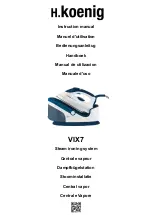
8
Selecting the steam
The quantity of steam is regulated by the steam selector
e
. Move the steam selector to a position between minimum and maximum
depending on the quantity of steam required and the temperature selected
[Fig. A].
Warning:
the iron gives off steam continuously only if you hold the iron horizontally. You can stop the continuous steam by placing the
iron in a vertical position or by moving the steam selector to “0”. As indicated on the thermostat knob
i
and in the initial table, you can
only use steam at the highest temperatures. If the selected temperature is too low, water may drip off the plate.
Selecting Super-steam and steam when ironing vertically
Press the super-steam button
c
to generate a powerful shot of steam that can penetrate the fabrics and smooth the most difficult and
tough creases. Wait for a few seconds before pressing again
[Fig. D]
.
By pressing the super-steam button at intervals you can also iron vertically (curtains, hung garments, etc.)
[Fig. E]
.
Warning: the super-steam function can only be used at high temperatures. Stop the emission when the plate temperature control light
f
comes on, then start ironing again only after the light has gone off.
DRY IRONING
To iron without steam, follow the instructions in section “steam ironing”, leaving the steam selector
e
on position “0”.
Spray Function
Make sure that there is water in the reservoir. Press the spray button
d
slowly (for a dense spray) or quickly (for a vaporised spray)
[Fig. F]
.
Warning:
for delicate fabrics, we recommend moistening the fabric beforehand using the spray function
d
, or putting a damp cloth
between the iron and the fabric. To avoid staining, do not use the spray on silk or synthetic fabrics.
CLEANING
Warning: before cleaning the iron in any way, make sure that the appliance is not plugged into the socket and that the plate
has cooled completely.
Any deposits, starch residue or size left on the plate can be removed using a damp cloth or an unabrasive liquid detergent.
Avoid scratching the plate with steel wool or metallic objects. The plastic parts can be cleaned with a damp cloth then wiped over with
a dry cloth.
SELF-CLEAN/CALC-CLEAN (where present)
The feature cleans inside the plate, removing limescale or other impurities. We recommend using it every 10-15 days. Directions:
- Fill the reservoir up to the maximum level indicated and set the steam selector
e
to “0”.
- Set the thermostat
i
to the maximum temperature and wait for the light
f
to turn off.
- Pull the plug out of the socket and hold the iron horizontally over the sink.
- Keep the steam switch on the Self-Clean/Calc-Clean setting (or press the button located under the handle according to model) until
all the boiling water, steam, impurities or limescale come out. When the soleplate has cooled down, you can clean it with a damp cloth.
HOW TO PUT IT AWAY
- Disconnect the plug of the iron from the socket. Empty the reservoir by turning the iron upside down and gently shaking it. Leave the
iron to cool down completely. Roll up the power cord with the rewinder
h
[Fig. G]
. Always put the iron away in a vertical position.
ADVICE FOR GOOD IRONING
We recommend using the lowest temperatures with fabrics that have unusual finishes (sequins, embroidery, flush, etc.).
If the fabric is mixed (e.g. 40% cotton 60% synthetics), set the thermostat to the temperature of the fibre requiring the lowest temperature.
If you don’t know the composition of the fabric, determine the suitable temperature by testing on a hidden corner of the garment. Start
with a low temperature and increase it gradually until it reaches the ideal temperature.
Never iron areas with traces of perspiration or other marks: the heat of the plate fixes the stains on the fabric, making them irremovable.
The size is more effective if you use a dry iron at a moderate temperature: excess heat scorches it with the risk of forming a yellow mark.
To avoid making silk, woollen or synthetic garments shiny, iron them inside out.
To avoid making velvet garments shiny, iron in one direction (following the fibre) and do not press down on the iron.
The heavier the washing machine is loaded, the more garments come out creased. This also happens when the spin drying revolutions
are very high.
Many fabrics are easier to iron if they are not completely dry. For example, silk should always be ironed damp.









































